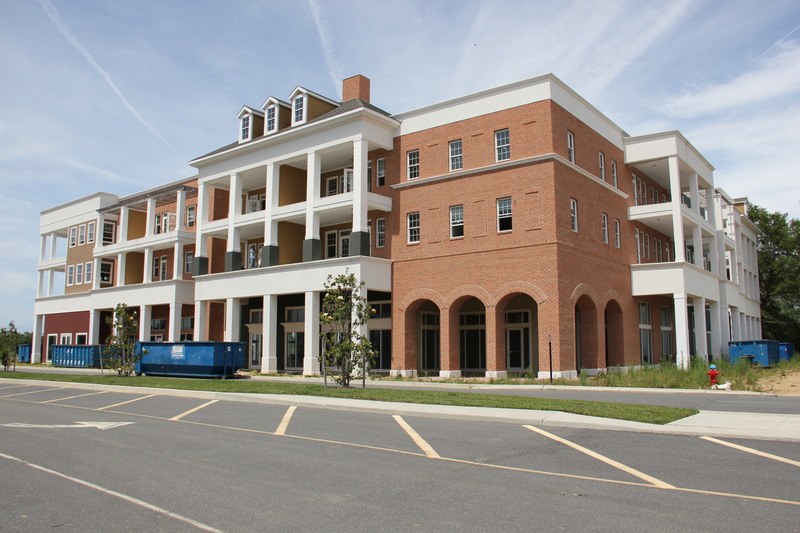The Vineyards at Nassau Valley project stands as one of the most visible local symbols of the market crash that ravaged the nation’s housing industry. When it started,the project was one of the most ambitious development projects ever undertaken in Sussex County.
After an 18-month hiatus, work recently resumed on the project, under new ownership and with far more conservative expectations.
When the unique project was first envisioned in 2002, the Ocean Atlantic development group was operating in the middle of a red hot market. Working in partnership with landowner Bob Raley, the group – financed by Wilmington Trust – embarked on a large-scale, mixed-use plan. Upon buildout, the 82-acre commercially zoned site would have included 927 residential condominium units, 350,000 square feet of commercial space and 75,000 square feet of office space.
Following principles laid out in Gov. Ruth Ann Minner’s Livable Delaware smart-growth initiative, the new urbanism plan would have clustered the townhouses in a dense living area around a town center fronting on a 10-acre pond. One third of the total acreage would have been preserved as open space. In addition, the project took advantage of a never-before-used provision in Sussex County zoning that allows buildings “of a public or semi-public nature” to rise to 60 feet. That provision allowed the design of mixed-use, 60-foot tall buildings with commercial space on the first levels and residential units above.
“In terms of intensity of use, difficulty and complexity, it was a very challenging project,” said Preston Schell, one of the principles in the Ocean Atlantic group. “In vertical, mixed-use developments like this one, the residential and commercial markets have to work at the same speed. It’s not like a horizontal mixed-use development like Paynter’s Mill where the residential and commercial components are separate. When the residential and commercial markets don’t work in unison – that causes serious problems for a vertically mixed use project.”
For the next three to four years after conception, the local market remained strong while design, land preparation and permitting efforts for the Vineyards project were underway. “But then the residential market turned south in 2006,” said Schell, “and everything turned south in 2008.”
Schell and his Ocean Atlantic partners went into prolonged negotiations with Wilmington Trust which was also reeling due to the crash and which eventually was bought out by M&T Bank. In January of 2011, work stopped on the Vineyards project with only one of the mixed-use buildings complete and another underway. None of the available retail space has ever been occupied. The majority of the residential units above the retail space, said Schell, were sold and the remainder have been rented.
New Jersey group buys in
Schell said the project and its assets are now owned by Fernmoor Holdings of Jackson, New Jersey. Terms of the settlement between the banks, Ocean Atlantic and Fernmoor have not been disclosed. Fernmoor president Jeffrey Fernbach said he bought the project through a complicated note sale involving the former Wilmington Trust and M&T Bank. “The sale also involved negotiations with Mr. Schell and Mr. Raley,” said Fernbach. “Right now we’re in a fact-finding mode, analyzing our future plans. We’re going to start with finishing the second building as well as the retail space available in the first building. It’s really very good space with tall ceilings and all state of the art. We’re trying to expedite that work so we can have that all completed as soon as possible. Then we’ll see where to go from there. It’s a great project and we’re excited to be involved with it.”
Fernbach said he plans to repave Nassau Commons Boulevard – which is part of the project – some time within the next nine months. Nassau Commons Boulevard is a private road that runs between Route 1 and Route 9 and which is widely used by emergency equipment of Lewes Fire Department and many others making their way back and forth between the two major highways.
According to information gleaned from the internet, Fernbach is also president of Paramount Homes which builds home in the Jersey shore area. According to the Paramount Homes website, Fernbach earned "Builder of the Year" honors for 2003 from the New Jersey Shore Builders Association (NJSBA) in recognition of his outstanding achievement in the building industry and his commitment to the betterment of the community.
Raley retains architectural control
Bob Raley said he still owns the land, and Fernbach owns the project and the land lease contract under which Ocean Atlantic was working. Raley said he retains architectural control over anything built on the land. He also said that his understanding is that Fernbach plans to complete construction on the second building and rent residential units in it. “When they rent them out, that’s when I get paid,” said Raley. “They’re supposed to start any time now. Finish this one and then start another. I don’t know how it will all turn out.”
Schell said Schell Brothers construction company has been retained by Fernbach to resume construction on the project. “The year-round market for residential rental units is on fire right now. There’s lots of demand so I think that’s the direction that will be taken for a while. The plan is to keep testing the market for residential condos – reacting to the market for the time being. There will be less retail in the development in the near term.” Schell also said attempts will be made to get retail tenants into the available commercial space. “There will be very competitive pricing to try to make that happen.” Schell said he understands the plan is to try to adhere as much as possible to the original concept. “But they’re much more sensitive to what the market will bear than we were.”
Schell said he has been watching stories recently about a regional planning initiative in the Delaware Cape Region. “One of the discussions has been about the emergence of a new town in the Five Points area. Our Vineyards project would be right at the epicenter of what they’re talking about. If our concept had ever taken hold, we would have had the kind of high density urban community they’re talking about – with the same kind of density as downtown Lewes and Rehoboth Beach.”


















































